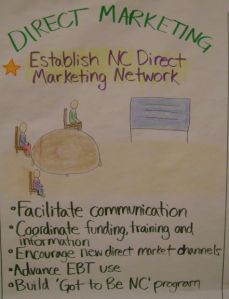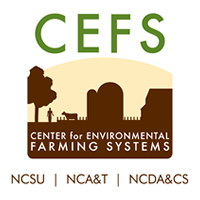To have your name added, contact Amber Polk at amber_polk@ncsu.edu.
Notes from the SUMMIT breakout sessions can now be found on the WIT pages linked below.
- F2F Core Team
- Game Plan
- Advisory Committee
- NC Food NETwork: a North Carolina Food System directory
- SUMMIT
- Working Issues
- Communications
- Community Gardens
- Direct Marketing
- Farm to School
- Local Government & Land Use
- New and Transitioning Farmer Support
- Processing & Food Systems Infrastructure
- Public Health & Food Access Disparities
- Retail & Institutional Markets
- Youth and Social Networking
- Formalizing the Initiative: Foundations & Baselines
- Regional Meetings
- How are we defining LOCAL?
- Regional Meetings Overview & Summary
- Triangle Region SUMMIT breakout session notes
- Mountain Region SUMMIT breakout session
- NorthEast Region SUMMIT breakout session notes
- Southeastern Region SUMMIT breakout session notes
- Triad Region SUMMIT breakout session notes
- Raleigh meeting
- Burgaw meeting
- Asheville
- Charlotte/Concord
- Winston-Salem
- Greenville
Golden Leaf Foundation
Z. Smith Reynolds
Ag Advancement Consortium
W.K. Kellogg Foundation
- CEFS
- Contact Information Form
- NC Choices
- NC Food Network
- Wayne Food Initiative
Direct Marketing

Highlights from Day 1 of the SUMMIT, May 11th:
• Participants recognized an amazing diversity of direct marketing opportunities across the state and the many different ways that direct marketing can occur
• With that, however, came the questions of what is the meaning of direct marketing? Is it, “you grow it AND sell it” or does the definition allow for other arrangements, people and businesses who help aggregate and distribute. No answers but lots of great questions and discussion.
• Serious recognition that direct marketing efforts have to tap into the use of new technology and social networking opportunities (e.g., “twitter your CSA members).
• Information-sharing occurred as well, in which participants got a good overview of the EBT process and regional branding efforts around.
Original WIT meeting facilitator & SUMMIT breakout leader:
- Debbie Hamrick, Director, Specialty Crops, N.C. Farm Bureau
Background
In recent years direct marketing has increased dramatically, which reflects substantial customer interest. Direct sales occur from farmers to consumers, either individually or as organizations. Direct market venues include roadside stands, city/regional/state-run farmers markets, Community Supported Agriculture (CSA) arrangements, food-buying clubs, e-commerce, and distribution businesses that aggregate products from individual farmers and coordinate delivery to consumers and markets such as restaurants. Farmers, particularly smaller-scale farmers, benefit from a short supply-chain because it allows them to collect a larger share of the retail price. Consumers benefit from access to fresh food and gain an understanding and appreciation for where their food comes from.
North Carolina Perspective
Nationwide, two percent of consumers report purchasing a majority of their foods at farmers markets. In North Carolina, there are approximately 87 farmers markets including those owned by farmers and five state-run, publicly funded markets. There are about 65 CSAs in North Carolina, many with long waiting lists of interested consumers. Newer models of direct-marketing include a work-place CSA at Research Triangle Institute, which involves several farms and numerous employees and a food buying club ,“Know Your Farm,” based in Davidson, which has more than 100 members and sources food from up to 20 farmers. There are branding efforts both at the local level (e.g., Appalachian Grown or Carteret Catch) and the state level (e.g., Got to Be NC) that enable consumer identification of regional products.
Issues Under Discussion
One of the greatest challenges to expanding direct marketing initiatives in many urbanized central and piedmont North Carolina regions is that there is greater customer demand than local producers can currently supply. In these areas, a community interested in starting a farmers market or CSA program may have trouble locating enough local farmers and/or enough diversity of food products to support the effort. There is a need for new direct marketing models, which could be created for example by engaging the business community. It will be important to address consumers’ need for more convenient access to local food (e.g., more drop off points for CSAs or increased hours of operation for farmers markets) and farmers’ need to reduce the time burden of managing booths at farmers markets. There is a need for expanded labeling of local products to provide customers with information and assurance about product origins. Product pricing is another core issue to address because while farmers are looking to be profitable, many consumers are looking for affordability, which is especially critical for low income consumers.
Notes from Direct Marketing WIT SUMMIT Breakout Session:
Game Changer Idea
Develop a NC Direct Marketing Network- a structured network whose mission is to enhance existing local efforts and encourage new innovations in direct marketing across the state.
- Another focus in marketing: importance of buying local—give them another reason to buy local.
- What is direct marketing- can there be an intermediary?
- Five NC state farmers markets- go beyond them. Some buying at wholesalers, selling as “local”- what is being sold that was grown by them. More than food shed. Need to define- maybe in terms of nutrition.
- DOT signage get help with that. Intergovernmental agency communication—DOT, NCDA, Commerce, DENR.
- Network and building around food-sheds for county based programs. Providing service will be hard beyond county borders
- Governor: Ag is green and brings green jobs.
- Cross promotion with youth and sports and local farmers markets
- Direct Marketing Association for the state- also local and regional too could do regional celebrations for example. Need funded position like in Agri-tourism to work with mid Atlantic Direct Marketing association. Also note that nearest markets may be in another state.
- Include fish- especially marine fish in local
- Cooperate with other small growers for CSAs
Other State Action Ideas
Better labeling and transparency- What is local- to one grocery store it is 600 miles. For most Americans the farmers market is the basis of local food. Need new dialogue with farmers at those markets. State run markets- resources available to them are limited.
EBT Program- Make Food Stamp program acceptable for CSAs.
Liability-Premise liability for tailgate markets- need specification of liability.
State Department of Food- Scary don’t mainstream everything
Other Ideas
- Small farmer how to connect them to outlets? Produce Box in Triangle has 800 families ordering from her needs growers.
- Diversity in this process
- Crafters can make a tailgate market interesting all year round. Mix in controlled fashion.
- Master gardeners took on as project a direct marketing brochure with local farm market farm stands.
more comments
- Conference to network
- Need to be able to say what things really are in terms of local and value
- Direct marketing allows farmers to sell #2’s Grocery stories only want #1’s.
- Southeast North Carolina Food Council has website- see our game changer in the five cities of the southeast region.
- Certain products hard to make money at- honey- good for market but not worth someone’s while. Maybe another can sell it for the producer.
